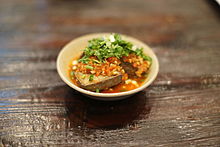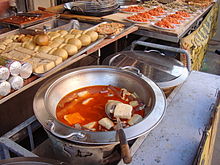Tofu
![]()
This article is about the Asian food product tofu. For the citation style TOFU in written communication, see TOFU.
![]()
This article or subsequent section is not sufficiently supported by evidence (e.g., anecdotal evidence). Information without sufficient evidence may be removed in the near future. Please help Wikipedia by researching the information and adding good supporting evidence.
Tofu - also known as bean curd - is a foodstuff originally from China and also from Asia, which is increasingly being used in the western world, especially in vegetarian and vegan diets.
Tofu is made from white soybeans processed into soymilk. The soy curd produced by denaturing and coagulating proteins is dehydrated and then pressed into blocks. This process is very similar to making cheese from milk.
Manufacture
Tofu is made by coagulating the protein components of soy milk, using either nigari (magnesium chloride), citric acid or calcium sulfate. These are then separated by heating and skimming or filtering. In Okinawa, sea water is used instead of nigari and such tofu is called shima-dofu (island tofu). Sometimes the tofu is also pressed to remove liquid.
The flocculation of the protein and the oil present as an emulsion from the cooked soy milk is the most important step in the production. This is achieved with the aid of coagulants. Two types, namely salts and acids, are used commercially. A third coagulant, enzymes, is not yet used commercially but appears promising for both solid and silken tofu.
Today's tofu manufacturers use one or more of these coagulation methods because they can be used to influence the desired texture of the finished tofu. The different textures are the result of different pore sizes and other features in tofu produced by using each type of coagulation. The mixture of coagulating agents is dissolved in water and the solution is then stirred into boiled soy milk until the mixture coagulates into a soft gel.
The blocks are made differently depending on the type of tofu. For soft silken tofu or for the "tofu flower", the soy milk is poured directly into the tofu's sales packaging, where it coagulates. For soft, standard tofu originating in Asia, the curdling of soy is stopped and the excess liquid is poured off using cotton or muslin; the remaining tofu is then lightly pressed to make a soft cake. For firmer types of tofu, such as Asian dry tofu, or even Western tofu, further pressing is done to remove even more liquid. The tofu blocks can then be refrigerated until they are firm. A finished block of tofu can be cut into several pieces, seasoned or otherwise processed. Acids are rarely used for seasoning, however, as the resulting flavor is often undesirable.
Tofu Types
Depending on the type of production and consistency, there are different types of tofu. For example, the so-called "silken tofu" is used for desserts, which is particularly tender in its consistency, while the "sponge tofu" is usually filled and deep-fried. Smoked tofu is also popular.
Fresh tofu
Depending on the water content extracted from the tofu blocks, fresh tofu in China and Japan can be divided into different types.
Silken Tofu
Silken tofu (in Chinese 嫩豆腐, nèn dòufu - "soft tofu" or 滑豆腐, huá dòufu - "smooth tofu"; in Japanese 絹ごし豆腐 kinugoshi tōfu, lit. "silk-filtered tofu"; in Korean 순두부 sundubu) is not drained and has the highest moisture content of any fresh tofu. Its texture can be compared to that of thin custard. In Japan and Korea, traditional silken tofu is made with seawater. At 1 mg per 100 g, the iron content is only a third of solid tofu and soybeans or a quarter of spinach.
Firm asian tofu
Firm Asian tofu (referred to in Chinese simply as 豆腐 dòufu; in Japanese 木綿豆腐 momendōfu, lit. "cotton tofu") is a fresh tofu variety that is dehydrated and pressed, but its moisture content is still very high. The firmness is comparable to fresh meat. The inner texture of this tofu is soft and has a consistency comparable to pudding. The outer skin has the pattern of muslin cloth or the sieve used for dehydration. A tofu preparation is also the tofu skin itself; in Japan it is called yuba.
Firm western tofu
Firm Western tofu (in Chinese 豆乾 / 豆干, doùgān - "dried tofu") is a particularly firm type of tofu that has the lowest moisture content of all fresh tofu. This variety is as firm as cooked-through meat and has a rubbery texture in some ways, similar to panir. When this tofu is thinly sliced, it can crumble easily. Its skin has the pattern of muslin cloth or the sieve used for dehydration. This tofu is ground and reshaped after pressing. Sometimes the skin with its cloth pattern is missing. A variety of dried tofu is pressed particularly flat and cut into long slices no more than two millimeters wide. Dried, minced tofu (in Chinese 荳乾絲 / 豆干丝, doùgānsī), which looks like loose cooked noodles, can be garnished in a variety of ways.
Processed tofu
There are several different types of processed tofu, analogous to the various ways in which fresh tofu can be prepared. Some of these techniques arose out of the need to preserve the tofu before it was possible to extend the shelf life through refrigeration. Other production techniques have been worked on to create tofu varieties that have unique textures and flavor characteristics.
Pickled tofu
Pickled tofu (in Chinese (豆)腐乳, (dòu)furǔ - "milk tofu", in Vietnamese chao) is also called preserved tofu or fermented tofu. These are cubes of tofu that have been air-dried through and slowly fermented by bacteria. The dry, fermented tofu is then soaked in salt water, Chinese wine, vinegar and with chopped peppers, or marinated with a special mixture of whole rice, bean paste and soybeans. For red pickled tofu (in Chinese 紅豆腐乳 / 红豆腐乳, hóng dòufurǔ), powdered red dates (Chinese jujube) or pickled red rice are added for color.
Processed tofu has a special mouthfeel similar to that of certain dairy products due to the composition of its proteins, and originates from air-drying and fermentation. Since it tends to be tasteless by nature, processed tofu takes on the smell and taste of the liquid in which it is soaked. The texture of pickled tofu resembles that of a firm and smooth paste, not unlike cold cream cheese. In fact, this type of tofu is sometimes referred to in English as chinese cheese. Pickled tofu usually has a very strong salty or spicy flavor, similar to many pickled Chinese vegetables. As such, it is often eaten as a side dish to a simple meal and is also a breakfast accompaniment if eaten with rice congee. Pickled tofu is generally sold in small canning jars and will keep for several years if stored in the refrigerator.
Stinky tofu
→ Main article: Stinky tofu
Stinky tofu (in Chinese 臭豆腐, chòudòufu) is a silken tofu that has been fermented with a special brine. These tofu blocks have a very strong smell of certain sharp cheeses. The texture of this tofu is similar to the Asian silken tofu from which it is made. It is usually served with soy sauce or sweet and/or hot sauce.
Frozen tofu
Frozen tofu (chi.: 冻豆腐 /dòng dòufu/) was discovered by Northern Chinese by accident when tofu stored outside was frozen in winter. Because of the ice crystals, holes appear and the tofu can absorb sauce well. Today, frozen tofu is usually produced with refrigeration equipment. In Northeast China, where the winter is particularly cold, frozen tofu is especially popular.
Thousand Layer Tofu
Thousand-layer tofu (Chinese 千葉豆腐 / 千叶豆腐, pinyin qiānyèdòufu or 冰豆腐, bīngdòufǔ or 凍豆腐 / 冻豆腐, dòngdòufǔ - "frozen tofu") is frozen tofu, which, when frozen, produces large ice crystals inside it, resulting in the formation of large, seemingly layered holes. The frozen tofu takes on a yellowish color when frozen. Thousand-layer tofu is often made in Asia from Asian silken tofu, and in parts of Taiwan it is also sold as a regional specialty. Before it is used, this tofu is thawed and the moisture squeezed out.
Japanese freeze-dried tofu
The name of Japanese freeze-dried tofu (in Japanese 高野豆腐 Kōya-dōfu) comes from Kōya-san, a center of Japanese Buddhism famous for its traditional vegetarian and Buddhist cuisine, the shōjin ryōri. This tofu is great for camping because it is very light, can be sold in flat-pressed form, and makes a nutritious meal on the go. Like many other freeze-dried foods, it is soaked in hot water or hot broth before eating, taking on a spongy consistency. Freeze-dried tofu is also found in bagged soups, such as miso soup.
By-products of tofu production
At the same time, the production of tofu also brings with it some thoroughly edible by-products. These edible products are obtained from an oil-protein layer or a kind of skin that forms over the surface of boiling soy milk in an open shallow pan. The remaining solid from pressing soy milk is called soy cake or okara.
Yuba
As the soy milk is cooked in an open shallow pan, a kind of layer or skin, consisting mainly of a complex of protein lipids, forms on the liquid surface. The layer is scraped together and dried in yellowish sheets. The result is called yuba or soy milk skin (Chinese 腐皮, fǔpí; Japanese 湯葉 yuba). It has approximately the following composition: 50-55% proteins, 24-26% fats, 12% carbohydrates, 3% ash, and 9% moisture.
The tofu skin can also be bundled to pin the shape and dried a kind of tofu bamboo (Chinese 腐竹, fǔzhú; Japanese kusatake), or prepared in countless other ways. Because tofu skin has a soft, rubbery texture, it is folded or shaped in various ways and cooked further for use in vegetarian and vegan cooking. Some factories dedicate their production to tofu skin and other products that come from soy skin.
Okara (soy cake)
Soy cake or okara (雪花菜, xuěhuācài - "snowflake vegetable" or 豆腐渣, doùfuzhā - "tofu sediment/residue"; Korean kongbiji), sometimes known as soy porridge in the West, is the residue left over from soy milk production from soaked soybeans. Although it is used primarily as animal feed in most cultures that produce tofu, it is sometimes used in Japanese and Korean cuisine. It is likewise used as an ingredient in vegetarian burgers, which are made in many Western countries. In Chinese cuisine, however, okara is rarely used.
Tofu made from other leguminous plants
Black bean tofu (Chinese 黑豆花, pinyin hēidòuhuā - "black tofu flower") is a type of tofu made from black soybeans, usually processed into a tofu flower (豆花, dòuhuā) instead of a solid or dried tofu. The texture of black bean tofu is slightly more gelatinous than a conventional tofu flower and has a gray-toned color. The black bean flavor is characteristic of this variety.
Peanut tofu (ryūkyū ジーマーミ豆腐, Jīmāmi dōfu) is made from peanuts and is considered a specialty of Okinawa.
Burmese tofu (in Burmese to hpu) is a type of tofu made from chickpea flour (chana dal) instead of soybeans. The shan variation uses pigeon peas instead. Both types are yellow in colour and are found only in Myanmar, although the Burmese variation is equally available in some overseas restaurants serving Burmese cuisine.
.jpg)
Defrosted tofu cut into pieces

Silken tofu with soy sauce

Two different preparations of tofu skin on offer at a small snack kitchen in TaipeiPicture series on Commons.

Guiliner pickled tofu

Stinky tofu in a spicy sauce on offer at a snack stall in the resort town of Fusing, Taiwan.
Search within the encyclopedia